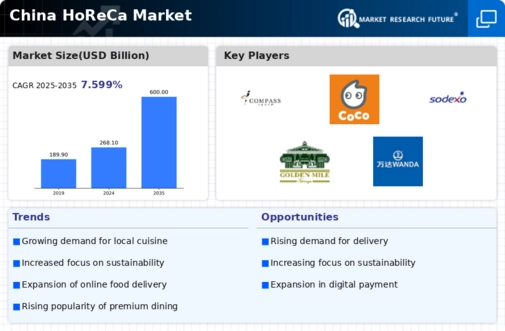Rising Disposable Incomes
The horeca market in China is experiencing a notable increase in disposable incomes among the middle class. As more consumers have access to higher earnings, their spending on dining and hospitality services is likely to rise. Reports indicate that the average disposable income in urban areas has grown by approximately 8% annually. This trend suggests that consumers are more willing to spend on premium dining experiences, thereby driving growth in the horeca market. Additionally, the expansion of urban centers and the influx of young professionals contribute to this phenomenon, as they seek diverse culinary experiences and social dining opportunities.
Health and Wellness Trends
There is a growing emphasis on health and wellness within the horeca market in China. Consumers are increasingly prioritizing nutritious and organic food options, which has led to a rise in demand for health-focused dining establishments. Data suggests that restaurants offering organic and health-conscious menus have seen a revenue increase of approximately 25% over the last year. This trend indicates a shift in consumer preferences towards healthier eating habits, prompting the horeca market to adapt by incorporating more wholesome ingredients and transparent sourcing practices. As health awareness continues to rise, this driver is expected to shape the future of dining in China.
Cultural and Culinary Exploration
The horeca market in China is witnessing a surge in interest towards diverse culinary offerings. As consumers become more adventurous, they are increasingly seeking out international cuisines and unique dining experiences. This trend is supported by data indicating that the demand for ethnic restaurants has grown by 20% over the past year. The horeca market is responding by incorporating a variety of global flavors and fusion dishes, appealing to the curiosity of the Chinese consumer. This cultural exploration not only enhances the dining landscape but also fosters a competitive environment among establishments.
Urbanization and Lifestyle Changes
China's rapid urbanization is significantly impacting the horeca market. With over 60% of the population now residing in urban areas, there is a growing demand for restaurants, cafes, and hotels. Urban dwellers tend to have different lifestyle preferences, often favoring convenience and quality in their dining choices. This shift is reflected in the increasing number of food and beverage establishments, which has risen by around 15% in major cities. The horeca market is thus adapting to cater to these evolving consumer preferences, emphasizing quick service and innovative dining concepts.
Government Support and Policy Initiatives
The Chinese government is actively promoting the horeca market through various policy initiatives aimed at boosting tourism and hospitality sectors. Recent measures include tax incentives for new restaurant openings and support for local food producers. Such policies are designed to enhance the overall dining experience and attract both domestic and international tourists. The horeca market stands to benefit from these initiatives, as they may lead to an increase in the number of establishments and a broader range of services offered. This supportive environment is likely to stimulate growth and innovation within the sector.
















Leave a Comment